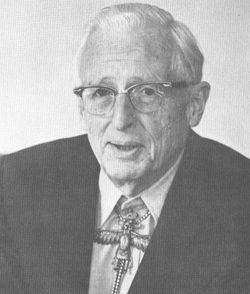Menzel was raised in Leadville, CO. He was a fast learner, reading "Gulliver's Travels" by the age of five, communicating in Morse code, and was an excellent science student, graduating high school by the age of 16. In his teens, he built his own amateur radio from scratch, and was licensed as ham radio operator W1JEX. He developed a strong early interest in Chemistry and graduated with a BA degree from the University of Denver, in just 3 years (1920). Then, the total solar eclipse of June 8, 1918 and Nova Aquilae sparked his interest and a career change to Astronomy. He then entered Princeton University on an Astronomy scholarship and graduated with a PhD degree in 1924.
Appointed to a position at Lick Observatory, Menzel performed groundbreaking research that determined the temperature of the Sun's chromosphere, and the abundance of the principal elements in solar-like stars. In 1932 he moved to Harvard, where during the next nine most productive years of his career, he applied the principles of quantum mechanics to spectroscopy to allow quantitative measurements of elemental abundances, which led to elucidating the chemical composition of stellar atmospheres. Menzel was a talented writer as well. In addition to his large volume of scientific articles and publications, he also wrote many books on popular science, which helped to spur more interest in astronomy among the general public.
In his personal life, he married Florence Kreager (1926), with whom he had two daughters, Suzanne and Elizabeth, and six grandchildren.
Menzel was raised in Leadville, CO. He was a fast learner, reading "Gulliver's Travels" by the age of five, communicating in Morse code, and was an excellent science student, graduating high school by the age of 16. In his teens, he built his own amateur radio from scratch, and was licensed as ham radio operator W1JEX. He developed a strong early interest in Chemistry and graduated with a BA degree from the University of Denver, in just 3 years (1920). Then, the total solar eclipse of June 8, 1918 and Nova Aquilae sparked his interest and a career change to Astronomy. He then entered Princeton University on an Astronomy scholarship and graduated with a PhD degree in 1924.
Appointed to a position at Lick Observatory, Menzel performed groundbreaking research that determined the temperature of the Sun's chromosphere, and the abundance of the principal elements in solar-like stars. In 1932 he moved to Harvard, where during the next nine most productive years of his career, he applied the principles of quantum mechanics to spectroscopy to allow quantitative measurements of elemental abundances, which led to elucidating the chemical composition of stellar atmospheres. Menzel was a talented writer as well. In addition to his large volume of scientific articles and publications, he also wrote many books on popular science, which helped to spur more interest in astronomy among the general public.
In his personal life, he married Florence Kreager (1926), with whom he had two daughters, Suzanne and Elizabeth, and six grandchildren.
Family Members
Sponsored by Ancestry
Advertisement
Explore more
Sponsored by Ancestry
Advertisement











